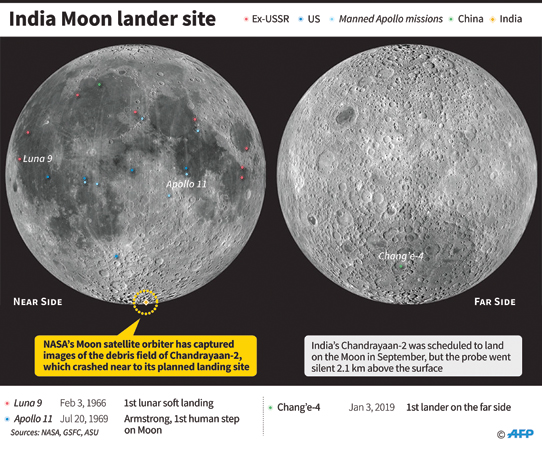

New York: Some three months after an unsuccessful Indian mission to the moon, the US space agency Nasa has found debris from parts of the unmanned spacecraft.
The “Vikram” lander shattered on the surface of the moon, but the main spacecraft remains in orbit.
It had dropped the lander for a descent to a previously unexplored region of the moon that should have taken five days.
However, it went silent about two kilometres from the surface of the moon.
On Monday, Nasa released an image, showing what it says is the site of the impact and the debris, which can be seen scattered over several kilometres.
Nasa credited an Indian engineer based in the southern city of Chennai with helping to identify the debris.
It said Nasa’s Lunar Reconnaissance Orbiter (LRO) Camera team released the first image of the site on September 26 and many people downloaded it to search for signs of Vikram.
“Shanmuga Subramanian contacted the LRO project with a positive identification of debris,” according to a Nasa release, which added that it was with the help of this tip that the LRO team confirmed the location.
Subramanian located the lander debris after working for up to seven hours a day using a laptop and Internet connection in his Chennai apartment, NDTV news channel reported.
“I narrowed my search to 2 square kilometres. I used only a laptop and searched all the images,” he was quoted as saying.
“It’s quite big but it is a little sad at the same time because we all expected Vikram to land on the surface,” Subramanian said. He hopes his discovery would inspire amateur space enthusiasts.
The Indian space agency Isro lost communication with the lander Vikram just minutes before the planned moon landing.
The lander was part of the unmanned $142-million “Chandrayaan2” mission.
Its aim was to study the surface of the moon’s south pole region, to analyse the ground, and to search for water.
A successful soft or controlled landing on the Moon’s surface would have made India the fourth country to have done so after the US, Russia and China.
An attempt by Israel earlier this year also ended in failure. — dpa
Oman Observer is now on the WhatsApp channel. Click here



